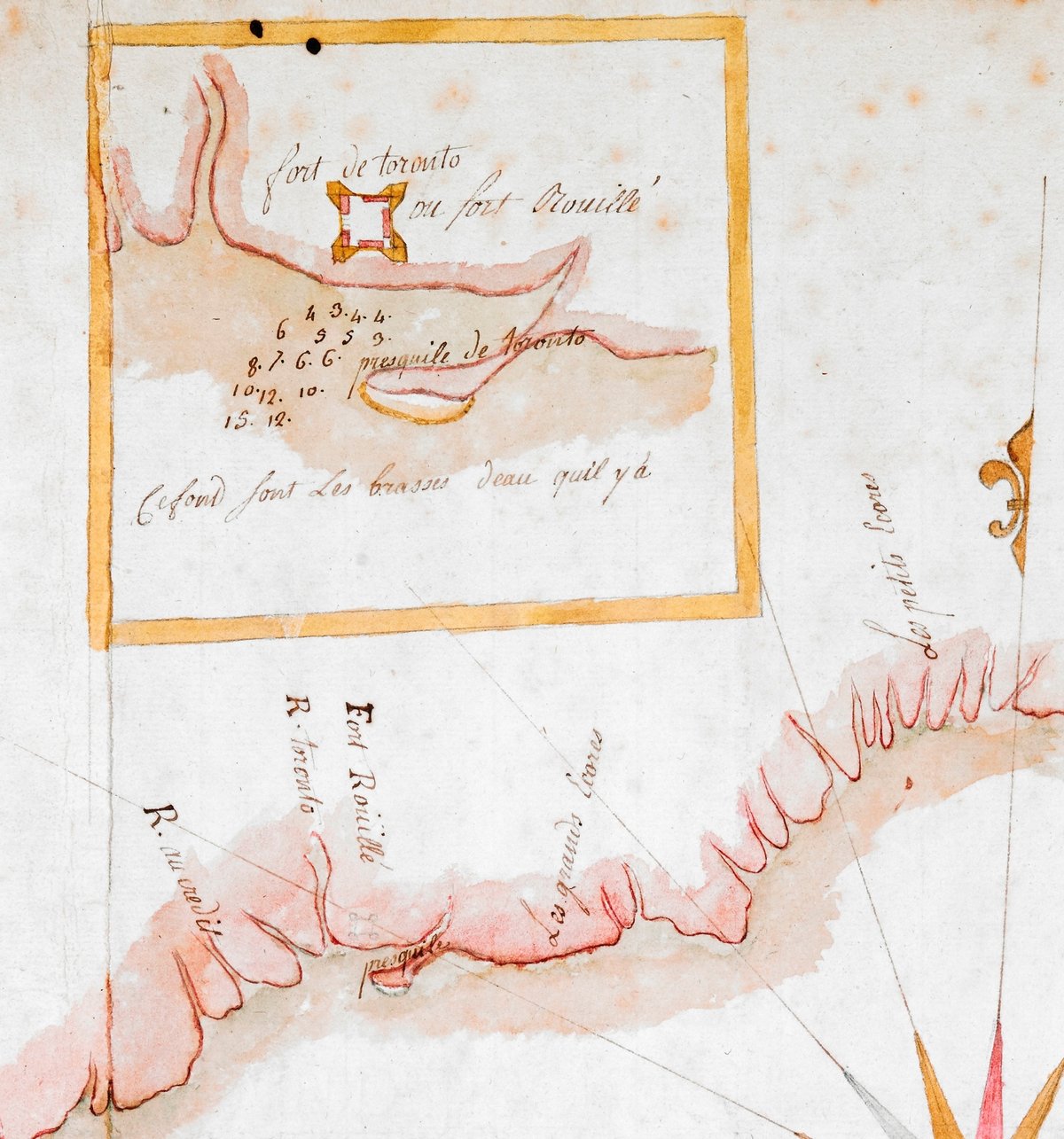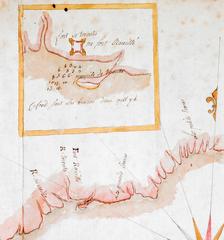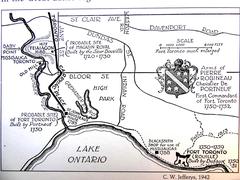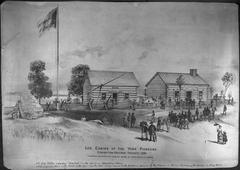
Fort Rouillé Visiting Hours, Tickets, and Tourist Guide – Toronto, Canada
Date: 14/06/2025
Introduction
Fort Rouillé, located within Toronto’s Exhibition Place, stands as a powerful reminder of the city’s colonial roots and the complex relationships between French settlers and Indigenous communities in the mid-18th century. Established as a French trading and military post in 1750–1751, the fort was strategically built near the mouth of the Humber River to foster fur trade, diplomacy, and to curb British influence in the region. Although the original structure was destroyed during the Seven Years’ War in 1759, the site’s legacy persists through commemorative monuments, archaeological findings, and interpretive programs.
This comprehensive guide covers everything you need to know about visiting Fort Rouillé: historical context, cultural relevance, practical details such as visiting hours and tickets, accessibility, travel tips, nearby attractions, and FAQs. Whether you are a history enthusiast, educator, family traveler, or a curious visitor, Fort Rouillé provides an accessible and enriching window into Toronto’s past.
For further background and visitor details, see World City History and Parks Canada.
Table of Contents
- Introduction
- History and Significance
- Archaeological and Heritage Value
- Visitor Information
- Travel Tips and Experience
- Nearby Attractions
- Cultural and Educational Importance
- Events and Programming
- Safety, Etiquette, and Preservation
- Frequently Asked Questions (FAQ)
- Conclusion and Recommendations
- References
History and Significance
Origins and Colonial Context
Fort Rouillé was constructed by the French in 1750–1751 and named after Antoine Louis Rouillé, the French Minister of Marine and Colonies. Its primary purpose was to strengthen French control over the fur trade and counteract British influence along the Great Lakes. The fort featured a palisaded enclosure with bastions, housing a small garrison and serving as a trading hub, particularly in partnership with the Mississaugas and other Indigenous groups (World City History).
Indigenous Relations and Trade
The area around Fort Rouillé was a traditional meeting place for Indigenous peoples, notably along the Toronto Carrying-Place Trail. The French leveraged these networks for fur trade and diplomacy, turning the fort into a seasonal hub of exchange and interaction. This period marked both cooperation and the beginning of European encroachment on Indigenous lands.
The Fort’s End
In 1759, as British forces advanced during the Seven Years’ War, the French abandoned and burned Fort Rouillé, signaling the end of French dominance in the region and paving the way for British rule. This pivotal event foreshadowed the establishment of York (later Toronto) as a British settlement in 1793.
Archaeological and Heritage Value
Rediscovery and Preservation
Rediscovered in the late 19th century, Fort Rouillé’s site has yielded artifacts such as musket balls, trade beads, and ceramics, offering valuable insight into daily life at the outpost and the broader colonial-Indigenous dynamic.
Commemoration
Today, the site is marked by a granite obelisk (erected in 1887), a stone cairn, bilingual plaques, and a concrete outline tracing the fort’s original footprint. Recognized as a National Historic Site of Canada, these markers preserve and interpret the fort’s story for contemporary visitors (Parks Canada).
Visitor Information
Location and Accessibility
- Address: 210 Princes’ Blvd, Toronto, ON M6K 3C3, within Exhibition Place.
- Transit: Accessible via TTC streetcar lines 509 and 511 (Exhibition Loop) and Exhibition GO Station.
- Parking: Available within Exhibition Place; may be limited during major events.
The site is fully wheelchair accessible, with paved paths and flat terrain ensuring ease of movement for all visitors.
Visiting Hours and Tickets
- Hours: Open year-round, 24 hours a day. No entrance gates.
- Tickets: Free admission. No tickets required.
Visitors are encouraged to visit during daylight hours for safety and optimal visibility.
Facilities
- On-site: Informational plaques (English and French), benches, stone obelisk, and outlined footprint.
- Restrooms and Amenities: Not available directly at the site, but accessible within Exhibition Place, especially during events.
Travel Tips and Visitor Experience
- Best Time to Visit: Spring to fall for pleasant weather; mornings and weekdays are usually quieter.
- Duration: 20–45 minutes is recommended to explore the site and read interpretive materials.
- Photography: The obelisk, footprint outline, and Toronto skyline provide excellent photo opportunities.
- Self-Guided Tours: Detailed signage supports self-guided exploration. For enhanced experiences, use walking tour apps like GPSmyCity.
- Accessibility: The site is stroller- and wheelchair-friendly; sun protection is advisable in summer.
Nearby Attractions
Fort Rouillé’s location within Exhibition Place makes it an ideal starting point to explore other sites:
- Scadding Cabin: Toronto’s oldest surviving building, adjacent to the fort’s markers.
- Exhibition Place Grounds: Including the CNE Bandshell, BMO Field, and Enercare Centre.
- Ontario Place: Waterfront park and entertainment area.
- Distillery Historic District: A short transit ride away, featuring Victorian architecture and arts venues.
- Martin Goodman Trail: Popular for walking and cycling along the waterfront.
See Secret Toronto for more ideas.
Cultural and Educational Importance
Fort Rouillé encourages reflection on Toronto’s layered history, from Indigenous meeting ground to French outpost and eventually a multicultural metropolis. The site is frequently included in educational programs, heritage festivals, and walking tours, helping to foster a deeper understanding of regional history and identity (World City History).
Events and Programming
Although Fort Rouillé does not host regular events, its proximity to Exhibition Place provides access to a range of city-wide festivals, concerts, and cultural celebrations, especially in summer. Notable annual events include:
- Canadian National Exhibition (CNE): Late August to early September.
- National Indigenous Peoples Day at Fort York: Cultural performances and educational activities (event details).
- Art Installations: Temporary exhibits during summer months.
Safety, Etiquette, and Preservation
- Conduct: Respect monuments and outlined features; avoid littering and climbing on structures.
- Pets: Dogs on leash are welcome.
- Sustainability: Stay on marked paths and dispose of waste responsibly. The site is maintained by the City of Toronto and heritage organizations (City of Toronto Heritage).
Frequently Asked Questions (FAQ)
Q: What are Fort Rouillé’s visiting hours?
A: Open 24 hours, year-round.
Q: Is there an admission fee or ticket required?
A: No, admission is free and tickets are not required.
Q: Are guided tours available?
A: No regular guided tours. The site is included in some self-guided walking tours via GPSmyCity. Educational programs and reenactments occur during certain events.
Q: Is the site wheelchair accessible?
A: Yes, paved paths and flat terrain ensure accessibility.
Q: Are there restrooms or food services?
A: Not on-site, but available within Exhibition Place, especially during events.
Q: Can I take photos?
A: Yes, photography is encouraged.
Visuals and Media
Visitors can preview Fort Rouillé via high-quality photographs and interactive maps available on Parks Canada, local tourism sites, and walking tour apps. Look for images labeled “Fort Rouillé stone cairn at Exhibition Place, Toronto historical site” to get a sense of the site’s features.
Recommendations and Travel Summary
- Allocate 30–45 minutes for your visit.
- Bring water, sun protection, and a camera.
- Combine your trip with nearby heritage sites such as Fort York and the Distillery District.
- Check the Exhibition Place events calendar for festivals or special programming.
Fort Rouillé is an essential landmark for understanding Toronto’s early colonial and Indigenous heritage. Open year-round with free admission and accessible pathways, it is an ideal destination for individuals, families, educators, and tourists. The fort’s commemorative markers, interpretive signage, and proximity to other attractions make it a rewarding stop on any Toronto history tour.
References
- Fort Rouillé: Visiting Hours, Tickets, and History of Toronto’s French Trading Post (Audiala)
- Visiting Fort Rouillé: History, Hours, Tickets, and Tips for Exploring Toronto’s Historic Site (World City History)
- Visiting Fort Rouillé: Hours, Tickets, and Toronto Historical Sites Guide (GPSmyCity)
- Fort Rouillé Visiting Hours, History, and Visitor Information: A Complete Guide to Toronto’s Historic Site (Parks Canada)
- City of Toronto Heritage – Fort Rouillé
- Trek Zone – Fort Rouillé
- BlogTO – Fort Rouillé Outline
- Secret Toronto – Things to do in June
Plan your visit to Fort Rouillé and immerse yourself in the roots of Toronto’s history. For more guides and updates, download the Audiala app and follow us on social media!





























































































































































































